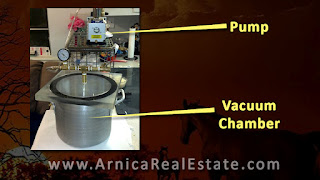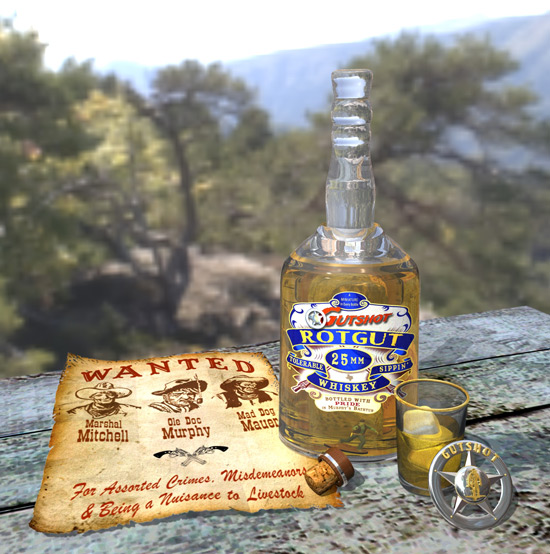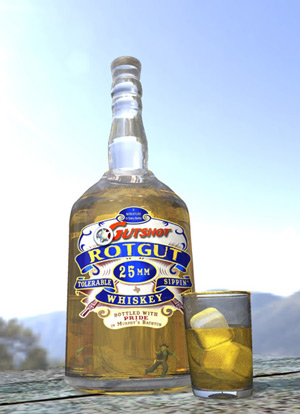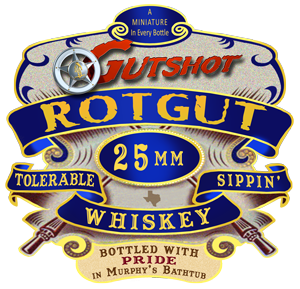In case you didn't know, Hawgleg Publishing also manufactures and sells resin buildings to use while playing
Gutshot. We sell these buildings under the name Arnica Real Estate (we inherited the name when we bought the Arnica line of buildings from Mark McGraw a few years aback). You can see the complete line of buildings over at
www.arnicarealestate.com.
Right now we're only offering buildings from our Western Collection:
http://www.arnicarealestate.com/cart_catHome.asp?ppcID=1 But I hope to start making some molds for the Adobe Collection later this week. Mosey on by the site to check out what we've got ready and what's next on the list.
Making buildings takes a lot of time and energy, as well as some specialized equipment. This week we launched a new Spring Reopening, so I'm working to fill orders and to replace some molds that have been damaged over the last year. One of the most important molds (at least in terms of sales) is for the boardwalks. There are three to a pack and, up until now, I've been operating with just two molds, and one of them actually tore across the bottom but is still usable. But, the truth is, it's gotten a bit rough and it needs to be retired. So, I need to make a new mold that will let me pour two boardwalks at a time (and with the other good Boardwalk mold I still have, I'll finally be able to pour a whole set at a single time).
Here's a quick photo strip of what I did tonight while making a new mold for the Boardwalks:
 |
| Two resin masters glued to a board. |
First I prepped the masters. They were already attached to the masonite board, so all I had to do was seal the edges.
You see, if there are any gaps between the resin master and the board, the rubber will seep into it and make it very hard to pull off the mold rubber after it solidifies.
 |
| Painters Tape seals it, the walls add structure. |
The next thing I did was build a mold box around the masters. Now, I'm bound to get some criticism form people for how I do this. I know most people use wooden boards and either clay or epoxy to create the walls around the masters. That's not how I ride, pilgrim.
I use 3-inch wide painters masking tape to adhere 1-inch thick Styrofoam blocks around the masters. These form the box walls.
I use this method because the Styrofoam is light, but at this thickness won't bend or bow against the weight of the rubber once the box is full. The painters tape forms a perfect rubber-tight seal (I use special corner joints to make sure there are no gaps at those crucial points).
 |
| Be careful to brush into the wood grain. |
Once the box is built, I then heat Petroleum Jelly in the microwave oven for about 5 minutes at 70% power. This softens it enough to make it easier to brush on.
I cannot stress the importance of this step!
It is absolutely VITAL that every tiny bit of the master is coated with a thin layer of petroleum jelly. If the layer is too thick, you'll lose the wonderful detail in the wooden planks of the boardwalk. If it's not thick enough, though, the rubber will probably tear during the de-molding step (which we'll look at on Thursday), thus wasting your work and your mold rubber.
 |
No kitchen is complete
without a vacuum pump! |
It's also important to coat the tape on the walls and the bottom of the mold. If you don't, tearing will almost certainly be in your future.
I took a picture of the next step, but you can't see it clearly enough to make it worth the effort to post it. The next step I take is to put a small 1/2 inch square wooden dowel along the edge of the box and mark a line with a pencil. I then put another one on top of that and mark again. This gives me two continuous pencil lines around the inside of the box to act as guides when I level the box after its full of rubber. I also use this line to make sure that my molds are at least a half-inch thick. Any less than that an there is a significant risk of tearing the mold as you work with it.
Next up, I get out the mold rubber (in this case,
Alumilite Quick Set) and mix it according to instructions (I'll discuss this more at a later date). Then it goes into the Vacuum Chamber. This is a vital step because mixing the rubber introduces a lot of air into it. Air can lead to bubbles which can lead to ruined molds. Our Vacuum Chamber is not your typical kitchen food-saver. This is a powerful 1/3 horse power motor capable of creating a pure vacuum.
 |
| In a vacuum, no one can hear you bubble. |
Once there is no air in the aluminum chamber, the mold rubber loses its surface tension, rises up about 2 inches and begins to "boil."
This is a COOL thing to watch. The thick goo looks a lot like pancake batter (with this rubber, it's particularly pancake-like because of its color and the way the bubbles pop on the surface). The bubbles keep roiling about until I finally break the vacuum and let the air back into the chamber. I actually took a video of this through the top of the chamber's clear lid. I'll post it to YouTube some time in the future.
By the way, yes that is dried resin in the bottom of the pot. I had an accident two weeks ago and the boiling resin overflowed the cup. I keep meaning to clean it up, but I keep getting sidetracked.
 |
| It must sit flat. |
After the resin has been degassed, I pour it into the mold box. The painters tape ad the Styrofoam walls hold up perfectly. Sorry I don't have any photos of me actually pouring the rubber, but it's sticky and I needed both hands to get the rubber into the box. In other words, I didn't want to get sticky rubber all over my camera phone!
Also, the pencil lines I mentioned help me level the mold as it cures. This particular type of silicon rubber takes about 4 hours to cure. However, I prefer to let it set for at least 12+ hours before I consider demolding it, and I won't use it for 24-48 hours, as that helps it cure more thoroughly.
It is very important to level the mold as the silicon rubber cures (i.e. hardens). If you don't, then the mold will be lopsided and every time I pour resin into it the final items won't be flat: one side will be thicker than the other. And that, of course, just ain't how we roll. The final step is to use a vibrator (the big type for your neck or back) on the table to help it jostle loose any bubbles that might be trapped below the surface. This is just a precaution as the degassing step removed most of them. This last vibro-step is "just in case" some air got caught beneath the undercut of the edge of the boardwalk.
If you'd like to take a gander at what we're going to make with this mold, you can see (and buy) it here:
http://www.arnicarealestate.com/cart_detail.asp?ppID=22
See ya Thursday for the demolding, and the first pour!






















